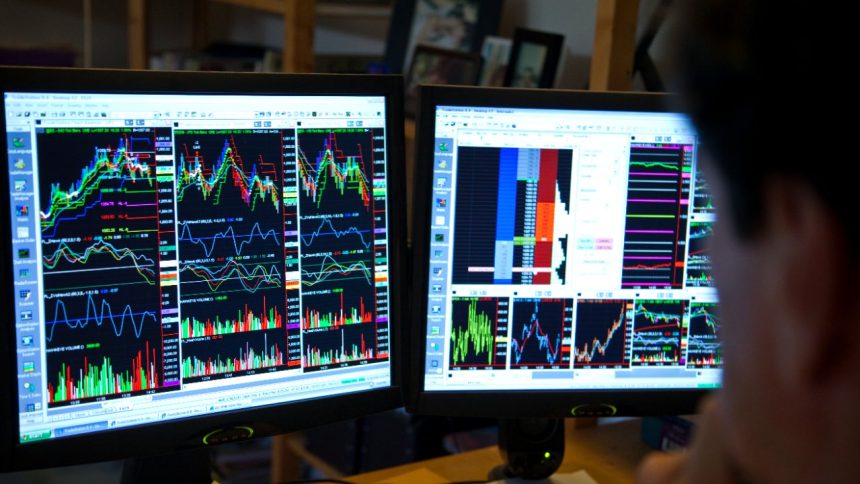Those involved in the stock market have many ways to make money, but these strategies can be boiled down to two big ones: investing and trading. One could say the difference between each strategy comes down to two things: time horizon (how long you’re willing to hold a position) and mindset (whether you think like an owner or like a flipper out for a short-term profit).
In contrast to what you see in Hollywood films and television, research suggests that the vast majority of market participants – virtually all – would do better if they adopted an investor mindset rather than a trader mindset. And that’s due to the many subtle costs and inefficiencies of trading.
Here’s the difference between investing and trading, and which one is likely to work better for you.
Investing vs. trading: How they differ
“With trading, you make money by acting; with investing you make money by waiting.” That’s one phrase that might sum up a key difference between investing and trading. Let’s break down the other key differences to see how they compare against each other:
Investing
If you’re investing, you’re taking a longer-term mindset about your investments and you’ll do things such as the following:
- You think like an owner, that is, about how the business will perform rather than just what the stock will do.
- Your long-term return relies fundamentally on the performance of the business, as opposed to skill in buying and selling better than other traders.
- You think about the business as a business – its products, how it competes and the evolving industry rivalries.
- You don’t worry about day-to-day fluctuations in the stock price, especially if the company’s long-term trajectory is on track.
- Because you’re thinking further out, you shake off short-term negative market reactions, such as when the company announces quarterly earnings.
- You’re able to sit patiently with your investments as they grow.
- You see a decline in the stock or a fund as a potential chance to own more shares in good businesses at a discounted price.
- If you’re investing in funds, you’ll tend to take a more passive approach, adding money regularly to your portfolio rather than trying to time the market.
- You sell investments based on process and discipline — when the investing case has played out — rather than because they did well this week or month.
Being an investor is about your mindset and process – long-term and business-focused – rather than about how much money you have or what a stock did today. You find a good investment and then you let the company’s success drive your returns over time.
Trading
If you’re trading, you’re focused much more on the short term, and you’re less interested in the business as a business. You’ll likely do some or all of the following things, such as:
- You’re less interested in whether the underlying business will thrive but more interested in whether the stock can make you money.
- You want to know what other people think about a trade because you’re not just playing the stock or fund but also the other players at the table.
- You may look at short-term price movements, even watching the charts by the minute to predict the best time to buy or sell, and you’re “timing the market.”
- Stock prices drive your behavior rather than the fundamentals of a business.
- You’re apt to ride the momentum stocks and look for stocks that are rising today rather than ones that are priced with a margin of safety.
- Your holding period tends to be short (perhaps just a day if you’re a day trader, or maybe a few weeks or months) depending on your specific strategy.
- You may sell investments based on process and discipline, but those trading rules have a lot more to do with how much you’ve made or lost than they do with the business itself.
- You may need to pay attention to the market more than you would as an investor since you need to make frequent buy and sell decisions.
Traders tend to have a short-term orientation. Being a trader relies less on analyzing a business than it does on looking at its stock as a way to turn a buck — and ideally the quicker, the better. Success here relies on outguessing the next trader, not necessarily on finding a great business.
Types of traders
- Day traders. These traders do just what it sounds like they do: trade positions throughout the day. They don’t typically hold any positions overnight and are therefore buying and selling on the same day.
- Position traders. This type of trading involves using longer-term charts to identify trends that can be acted on by traders. These traders are positive when the market is rising and negative when it is falling, only buying or selling once a trend has been established. If things change, they’ll typically exit their positions.
- Swing traders. A swing trader will try to analyze and identify when a trend is about to change and take positions to potentially profit from that change, or swing. These trades are typically held for more than a day, but less than that of position traders.
- Scalping. This is one of the fastest methods employed by traders and it involves profiting off of a short-term imbalance in supply and demand for a security that causes the bid-ask spread to be wider or more narrow than usual. These traders count on making a large number of small gains and prefer to work with highly liquid securities.
Investing works better than trading for most
If the distinction between investing and trading sounds a lot like that between active investing and passive investing, it should! These pairs of investing approaches have many similarities.
Passive investing is a buy-and-hold strategy that relies on the fundamental performance of the underlying businesses to drive returns higher. So when you take a stake, you expect to hold it for a while, not simply sell it when the price jumps or before the next person offloads their stake.
Passive investing via funds (either ETFs or mutual funds) lets you enjoy the return of the target index. For example, the Standard & Poor’s 500 index has returned an average of about 10 percent annually over time. That would be your return if you had bought into an S&P 500 index fund and not sold it.
Active investing is a strategy that tries to beat the market by trading in and out of the market at advantageous times. Traders try to pick the best opportunities and avoid falling stocks.
While active investing seems like it would be the consistent winner, research shows that passive investing tends to win the majority of the time. A 2024 study from S&P 500 Dow Jones Indices shows that 93 percent of fund managers investing in large firms didn’t beat their benchmark index over the previous 20 years. And over time only a handful could do so, with 92 percent of the professionals unable to beat the market over a 15-year period.
These are pros who have experience, knowledge and computing power to help them excel in a market dominated by turbocharged trading algorithms that have well-tested methodologies. That leaves very few crumbs for individual traders without all those advantages.
So investors are more likely to prefer a passive approach to the markets, whether they invest in individual companies or funds. Traders are more likely to prefer an active approach.
3 hidden costs of trading to watch for
Trading has a number of hidden costs, things that ultimately make it less profitable for most traders than sticking to an investing approach. Here are three of the most common:
1. Trading is a zero-sum game
Trading operates on what’s called a zero-sum game. That is, if someone wins, it comes at the loss of someone else. For example, options trading is essentially a series of side bets between traders on the performance of a stock. If a contract is in the money by $1,000, the winning trader gets exactly that money, effectively taking it from the losing trader.
So trading is just shuffling money around from player to player, with the sharpest players rolling up more money over time from less-adept players. In contrast, investors are playing a positive sum game, where more than one person can win. Investors make money when the business succeeds over time.
2. It’s easy to miss the big days as a trader
Traders may think that they’re being crafty by ducking and dodging, but they often miss the market’s biggest days because they’re out of the market or only partially invested.
A report from Bank of America reveals how being out of the market can be so damaging. The data shows that the S&P 500’s total return from 1930 through 2020 was 17,715 percent. But what’s the total return if you had missed just the market’s 10 best days each decade? The result: a mere 28 percent total over the entire period, from missing fewer than 100 total days.
Market pundits have a saying: “Time in the market is more important than timing the market.” That is, it’s more important to stay invested than it is to try to dodge losses and pick off gains. And that’s where the long-term mentality of an investor helps you focus on the future. You ride out the bad days because the market as a whole has been on a long-term upward trajectory.
3. Traders run up taxes
You create a tax liability every time you realize profits on an asset sale. So traders who bounce in and out of the market are realizing profits (or losses) all the time. That reduces their ability to compound gains, because they have to cut the IRS in for a slice of every gain they realize.
In contrast, investors tend to let investments run. And because the government doesn’t require you to pay tax until you sell an investment, investors are able to compound at a higher rate, all else equal. In other words, they effectively force the government to give them an interest-free loan by deferring their taxes, and they continue to compound on the full, pre-tax amount.
For instance, imagine you started with $10,000 and gained 20 percent annually for five years but sold each year and incurred taxes of 20 percent each year. At the end of the five-year period, you’d have assets of $21,000 – good for about 16 percent annualized gains. Not bad!
But you’ll have even more if you hadn’t sold. Without selling, you’d have turned that $10,000 into more than $24,883 and kept the entire 20 percent annualized gains. And if you decided to sell then? You’d still have $21,906 after taxes, or nearly 17 percent annually over the period.
That’s a hidden advantage that investors have over traders.
Bottom line
The evidence is clear that investing is a strategy that works better for most people. Can some traders consistently beat the market? Absolutely, no question. But for most people it’s better to be an investor than a trader – and it can take less time and effort, too.
Legendary investor Warren Buffett recommends that investors regularly buy into an index fund such as an S&P 500 fund and then hold for decades. This approach follows the spirit of being an investor – taking a long-term mindset and letting the businesses generate gains for you.
— Bankrate’s Brian Baker contributed to an update of this story.
Read the full article here
















